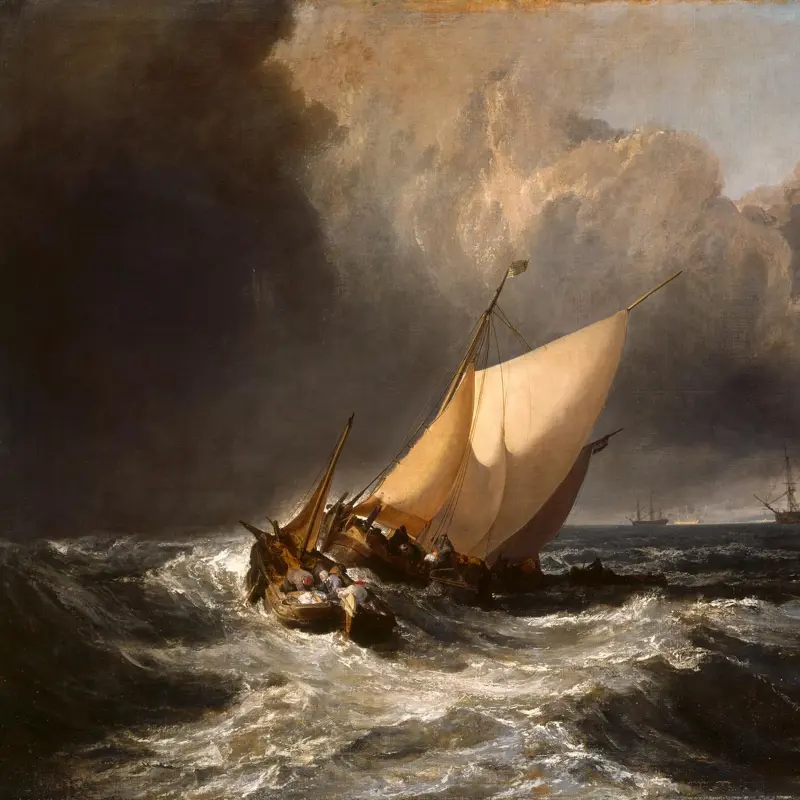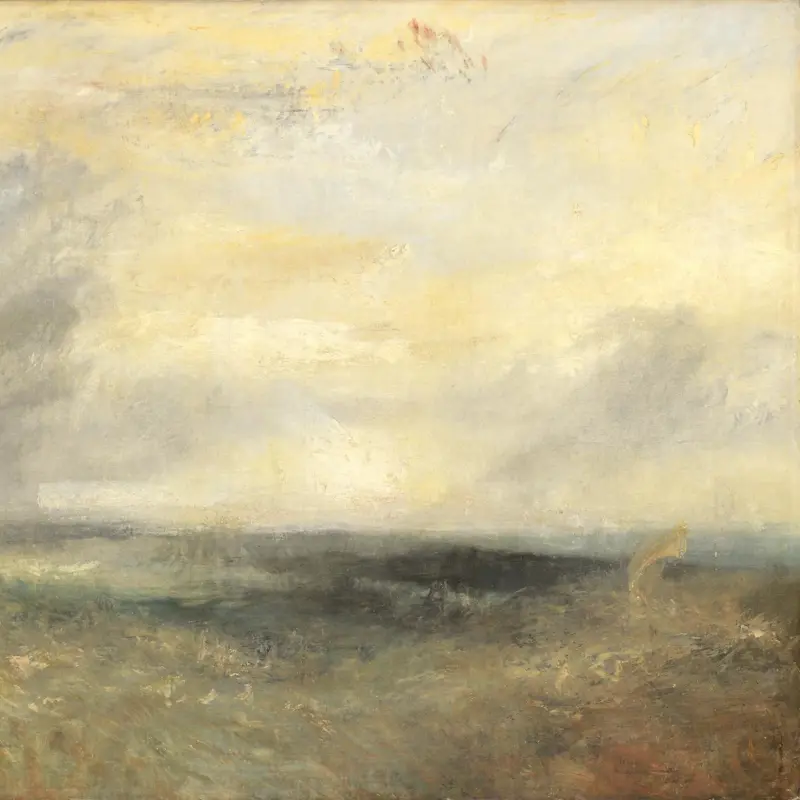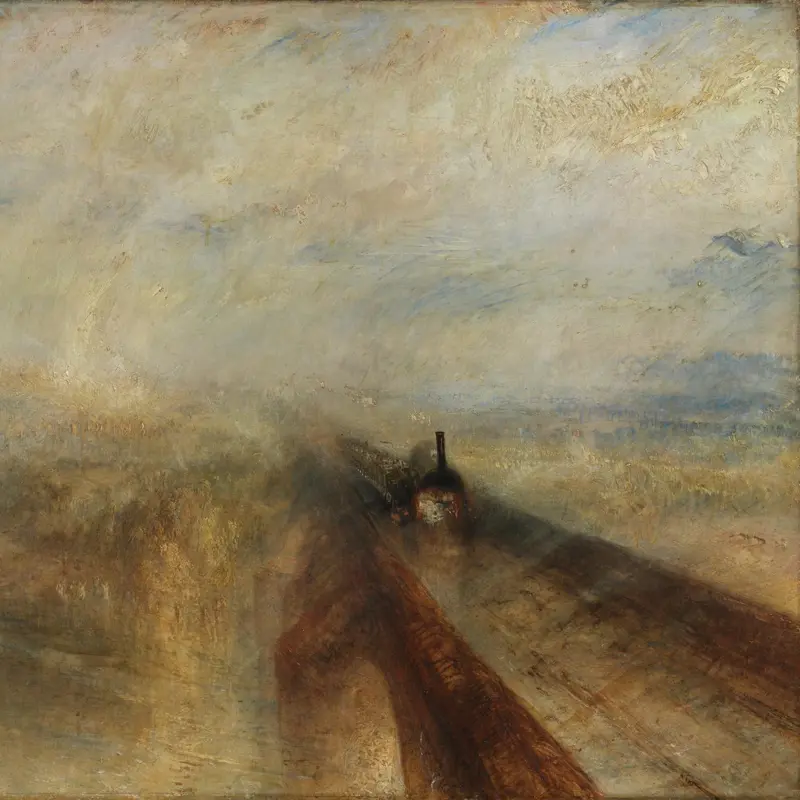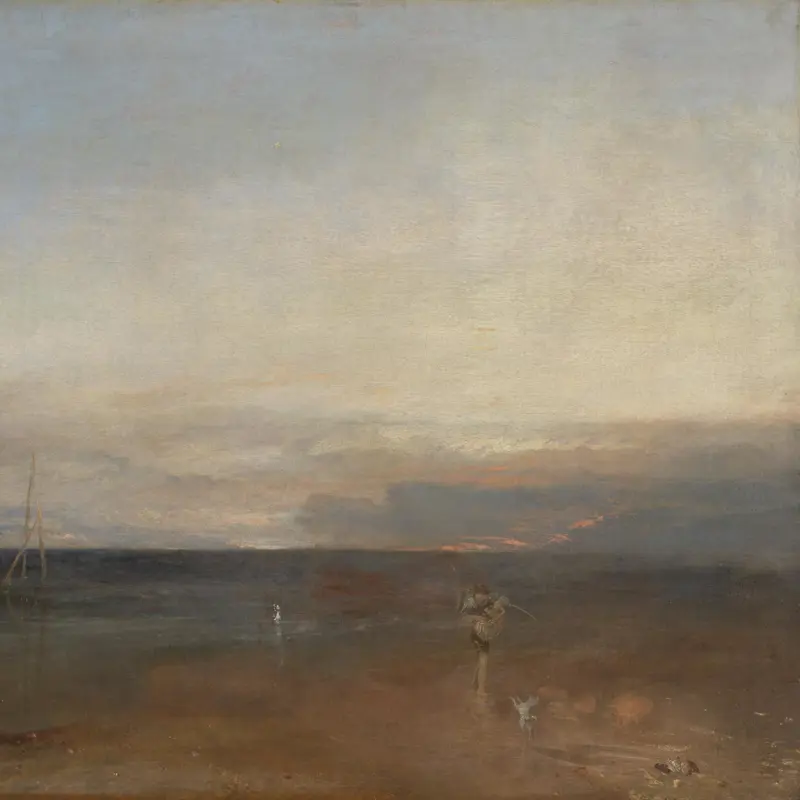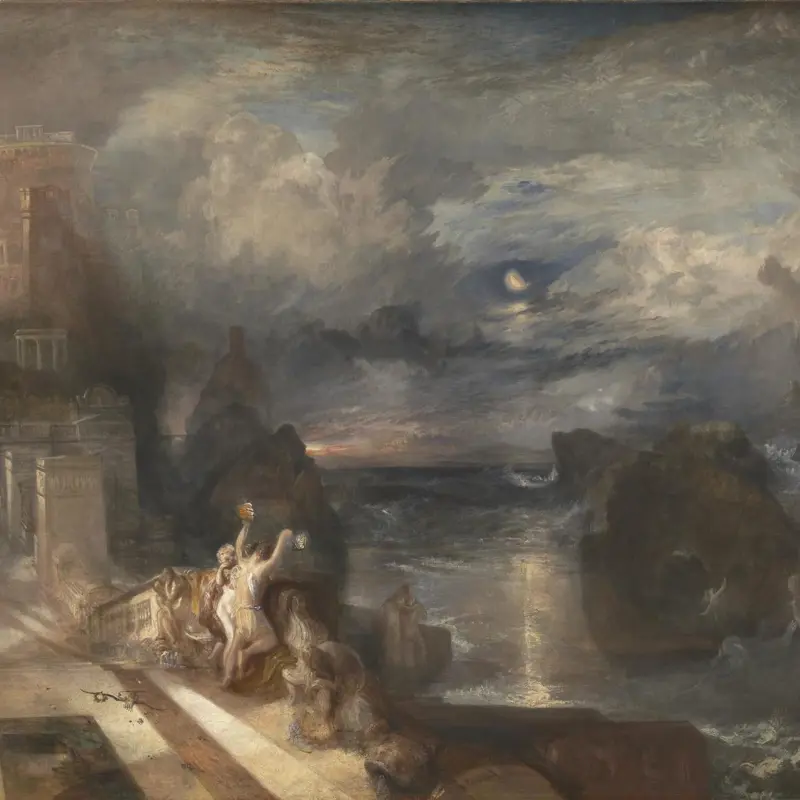Joseph Mallord William Turner, 'Sun Rising through Vapour', before 1807
About the work
Overview
It is low tide in the early morning and fishermen unload their catch from a boat beached high and dry on the shore. Some people enjoy a meal. Others prepare the catch for sale. This human activity contrasts with the stillness of the glassy sea which, like a mirror, reflects the hazy sunlight. The pale yellow sun is not yet hot enough to burn off the sea mist – the ‘vapour’ referred to in the picture’s title – which gives the large warships in the background an almost ghostly aura.
As a study of a calm, smooth sea, this picture was a departure from the wild storms of Turner’s previous marine paintings. The boats and figures recall the work of Dutch painters, an influence acknowledged by the picture’s later title, Dutch Boats, when it was exhibited in Turner’s own gallery in 1810.
Key facts
Details
- Full title
- Sun rising through Vapour: Fishermen cleaning and selling Fish
- Artist dates
- 1775 - 1851
- Date made
- Before 1807
- Medium and support
- Oil on canvas
- Dimensions
- 134 × 179.5 cm
- Acquisition credit
- Turner Bequest, 1856
- Inventory number
- NG479
- Location
- Room 36
- Collection
- Main Collection
- Previous owners
- Frame
- 19th-century English Frame
Provenance
Additional information
Text extracted from the ‘Provenance’ section of the catalogue entry in Judy Egerton, ‘National Gallery Catalogues: The British Paintings’, London 2000; for further information, see the full catalogue entry.
Exhibition history
-
2009Turner and the MastersTate Britain23 September 2009 - 31 January 2010Galeries Nationales du Grand Palais22 February 2010 - 24 May 2010Museo Nacional del Prado22 June 2010 - 19 September 2010
-
2012Turner Inspired: In the Light of ClaudeThe National Gallery (London)14 March 2012 - 5 June 2012
Bibliography
-
1809British Institution, Catalogue of the Works of British Artists Placed in the Gallery of the British Institution, Pall-Mall, for Exhibition and Sale, London 1809
-
1819W. Carey, A Descriptive Catalogue of Paintings by British Artists in the Possession of Sir John Fleming Leicester, Bart, London 1819
-
1821J. Young, A Catalogue of Pictures by British Artists in the Possession of Sir John Fleming Leicester, Bart., with Etchings from the Whole Collection, London 1821
-
1857R.N. Wornum, Descriptive and Historical Catalogue of the Pictures in the National Gallery, with Biographical Notices of the Painters: British School, London 1857
-
1879P.G. Hamerton, The Life of J.M.W. Turner, R.A., London 1879
-
1908W.G. Rawlinson, The Engraved Works of J.M.W. Turner, 2 vols, London 1908
-
1928W.T. Whitley, Art in England 1800-1820, Cambridge 1928
-
1930W.T. Whitley, Art in England 1821-1837, Cambridge 1930
-
1939A.J. Finberg, The Life of J.M.W. Turner, R.A., Oxford 1939
-
1946Davies, Martin, National Gallery Catalogues: British School, London 1946
-
1946M. Davies, Paintings and Drawings on the Backs of National Gallery Pictures, London 1946
-
1951H.F. Finberg, 'Turner's Gallery in 1810', The Burlington Magazine, XCIII, 1951, pp. 383-6
-
1959Davies, Martin, National Gallery Catalogues: British School, 2nd edn (revised), London 1959
-
1960D. Hall, 'The Tabley House Papers', The Walpole Society, XXXVIII, 1962, pp. 59-122
-
1965J. Gage, 'Turner and the Picturesque', The Burlington Magazine, CVII/742, 1965, pp. 16-26
-
1969D. Hirsch, The World of Turner, New York 1969
-
1974G. Wilkinson, The Sketches of Turner, R.A., 1802-1820, London 1974
-
1977K.D. Nicholson, J.M.W. Turner's Images of Antiquity, Phd Thesis, University of Pennslyvania 1977
-
1978A. Macintyre and K. Garlick (eds), The Diary of Joseph Farington, vol. 5, New Haven 1978-1984
-
1978D. Robertson, Sir Charles Eastlake and the Victorian Art World, Princeton 1978
-
1982M. Butlin and E. Joll, L'opera completa di Turner 1793-1829, Milan 1982
-
1983M. Kitson, 'Turner and Claude', Turner Studies, II/2, 1983, pp. 2-15
-
1984A. Wilton, 'The "Monro School" Question: Some Answers', Turner Studies, IV/2, 1984, pp. 8-23
-
1986S. Whittingham, 'A Most Liberal Patron: Sir John Fleming Leicester, Bart., 1st Baron de Tabley, 1762-1827', Turner Studies, VI/2, 1986, pp. 24-36
-
1987P. Bicknell and H. Guiterman, 'The Turner Collector: Elhanan Bicknell', Turner Studies, VII/1, 1987, pp. 34-44
-
1988D. Hill, 'Turner at Farnley Hall', in D. Hill (ed.), Turner's Birds: Bird studies from Farnley Hall, Oxford 1988, pp. 9-24
-
1990S. Ginzburg, Turner, New York 1990
-
1990E. Shanes, Turner: The Masterworks, London 1990
-
1994F.G.H. Bachrach, Turner's Holland (exh. cat. Tate Gallery, 22 July - 2 October 1994), London 1994
-
1995K.D. Kriz, 'Dido Versus the Pirates: Turner's Carthaginian Paintings and the Sublimation of Colonial Desire', Oxford Art Journal, XVIII/1, 1995, pp. 116-32
-
1997J. Hamilton, Turner: A Life, London 1997
-
1998J. Egerton, The British School, London 1998
-
2000Egerton, Judy, National Gallery Catalogues: The British Paintings, revised edn, London 2000
-
2001
C. Baker and T. Henry, The National Gallery: Complete Illustrated Catalogue, London 2001
-
2003P. Spencer-Longhurst, The Sun Rising through Vapour: Turner's Early Seascapes (exh. cat. The Barber Institute of Fine Arts, 24 October 2003 - 25 January 2004), Birmingham 2003
-
2004J. Collins, Turner, Whistler, Monet (exh. cat. Art Gallery of Ontario, 12 June - 12 September 2004; Grand Palais, 11 October 2004 - 17 January 2005; Tate Britain, 10 February - 15 May 2005), Toronto 2004
Frame
This nineteenth-century English frame, crafted in pinewood and oil-gilded, has housed Turner’s Sun Rising through Vapour since 1986. It is embellished with English neoclassical-style ornaments made from composition. The back edge is decorated with a ribbon-and-stick pattern. The top edge features a guilloche, which is followed by a plain hollow with acanthus-leaf corners. The sight edge is embellished with a leaf-and-tip motif.
When the frame was chosen to accompany the painting, it was in poor condition and required significant restoration, including the addition of a new back and sight edge, with new composition designs to replace missing sections. The damaged gilding was also covered with oil gilding to restore its appearance.
It is unclear what frame originally accompanied Sun Rising through Vapour when it entered the collection, although discussions about reframing began as early as 1958. In the late 1960s, a plain, modern architectural moulding was fitted before the current frame replaced it.
About this record
If you know more about this work or have spotted an error, please contact us. Please note that exhibition histories are listed from 2009 onwards. Bibliographies may not be complete; more comprehensive information is available in the National Gallery Library.



